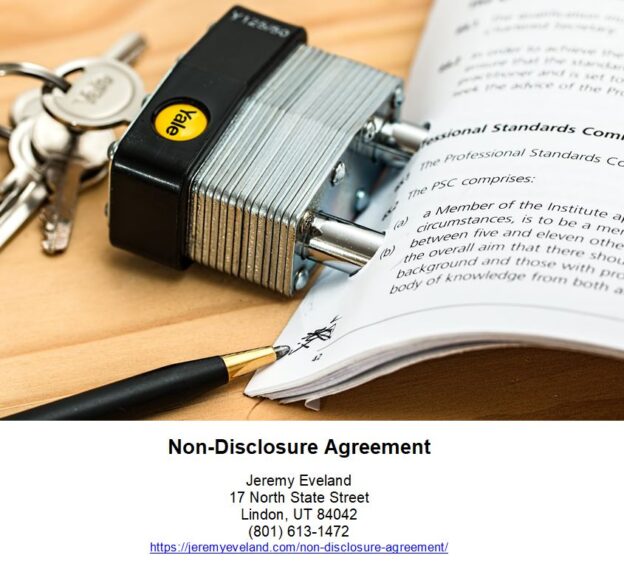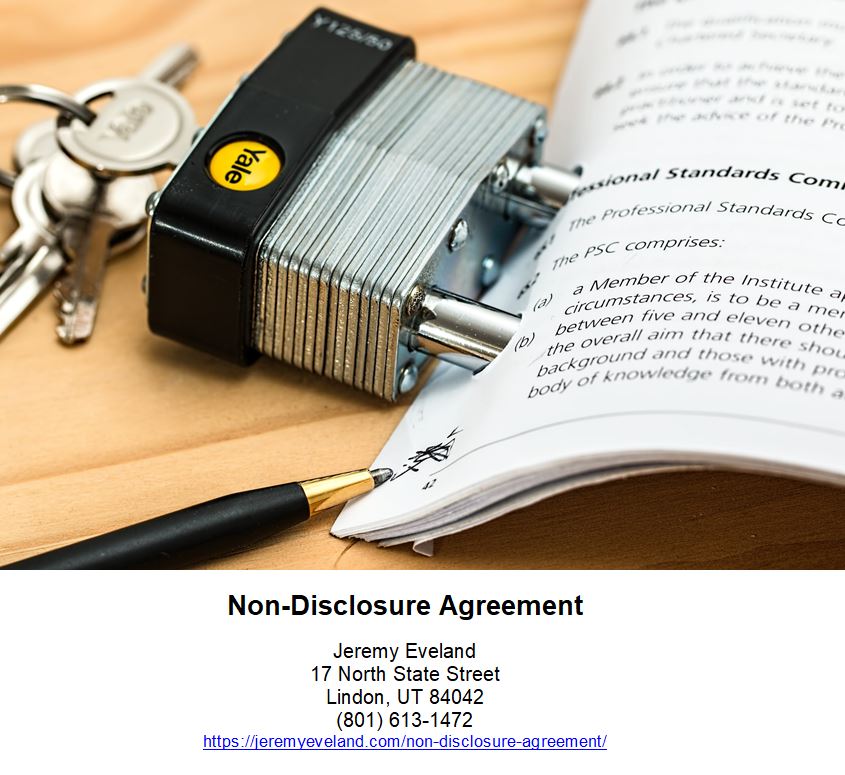Non-Disclosure Agreement
-
Utah Lawyer
- Introduction
- How to Draft a Non-Disclosure Agreement for Your Business
- What Are the Legal Implications of Breaking a Non-Disclosure Agreement?
- What Are the Different Types of Non-Disclosure Agreements?
- What Are the Benefits of Having a Non-Disclosure Agreement?
- What is a Non-Disclosure Agreement (NDA) and How Does it Work?
- Why You Need A Lawyer to Assist You With a Non-Disclosure Agreement
- Q&A
“Protecting Your Confidentiality – A Non-Disclosure Agreement is Your Best Defense.”
Introduction
A Non-Disclosure Agreement (NDA) is a legally binding contract between two or more parties that outlines confidential material, knowledge, or information that the parties wish to share with one another for certain purposes, but wish to restrict access to or by third parties. It is a contract through which the parties agree not to disclose information covered by the agreement. NDAs are commonly used when two companies, individuals, or other entities are considering doing business and need to understand the processes used in each other’s business for the purpose of evaluating the potential business relationship. NDAs can also be used to protect any type of confidential information, such as trade secrets, proprietary information, or any other confidential information that may be disclosed during the course of a business relationship.
How to Draft a Non-Disclosure Agreement for Your Business
A non-disclosure agreement (NDA) is a legally binding contract between two or more parties that outlines confidential material, knowledge, or information that the parties wish to share with one another for certain purposes, but wish to restrict access to or by third parties. An NDA is an important tool for businesses to protect their confidential information and trade secrets.
Non-Disclosure Agreements are a part of Contract Law.
When drafting an NDA for your business, there are several key elements to consider.
1. Parties: The NDA should clearly identify the parties involved in the agreement. This includes the names of the parties, their addresses, and contact information.
2. Purpose: The NDA should clearly state the purpose of the agreement and the confidential information that is being shared.
3. Obligations: The NDA should outline the obligations of each party, including the obligation to keep the confidential information confidential and the obligation to not use the confidential information for any purpose other than the purpose stated in the agreement.
4. Duration: The NDA should specify the duration of the agreement and the circumstances under which the agreement may be terminated.
5. Remedies: The NDA should outline the remedies available to the parties in the event of a breach of the agreement.
6. Miscellaneous: The NDA should include any other provisions that are necessary to protect the interests of the parties.
By including these key elements in your NDA, you can ensure that your confidential information is protected and that your business is safeguarded from potential legal issues.
What Are the Legal Implications of Breaking a Non-Disclosure Agreement?
Breaking a non-disclosure agreement (NDA) can have serious legal implications. Depending on the terms of the agreement, a breach of an NDA can result in civil and/or criminal penalties.
In a civil case, the aggrieved party may seek monetary damages for any losses suffered as a result of the breach. This could include lost profits, reputational damage, or other economic losses. The court may also order the breaching party to pay the aggrieved party’s legal fees.
In some cases, a breach of an NDA may also be considered a criminal offense. Depending on the jurisdiction, a breach of an NDA may be considered a misdemeanor or a felony. If convicted, the breaching party may face fines, jail time, or both.
In addition to the legal consequences, a breach of an NDA can also have serious professional and personal repercussions. A breach of an NDA can damage a person’s reputation and credibility, making it difficult to find future employment or business opportunities.
It is important to remember that NDAs are legally binding contracts. Before signing an NDA, it is important to understand the terms and conditions of the agreement and to ensure that you are able to comply with them. If you have any questions or concerns, it is best to consult with an attorney before signing.
What Are the Different Types of Non-Disclosure Agreements?
Non-disclosure agreements (NDAs) are legally binding contracts that protect confidential information from being shared with third parties. They are commonly used in business transactions, such as when two companies are considering a merger or when a company is hiring a consultant. There are several different types of NDAs, each with its own purpose and set of rules.
1. Unilateral NDA: A unilateral NDA is a one-way agreement in which one party agrees to keep the other party’s information confidential. This type of NDA is often used when a company is hiring a consultant or contractor to work on a project.
2. Mutual NDA: A mutual NDA is a two-way agreement in which both parties agree to keep each other’s information confidential. This type of NDA is often used when two companies are considering a merger or when two companies are entering into a joint venture.
3. Employee NDA: An employee NDA is an agreement between an employer and an employee that outlines the confidential information the employee is not allowed to share. This type of NDA is often used to protect trade secrets and other proprietary information.
4. Non-Compete NDA: A non-compete NDA is an agreement between an employer and an employee that prohibits the employee from working for a competitor or starting a competing business. This type of NDA is often used to protect a company’s competitive advantage.
5. Non-Solicitation NDA: A non-solicitation NDA is an agreement between an employer and an employee that prohibits the employee from soliciting the employer’s customers or employees. This type of NDA is often used to protect a company’s customer base and employee talent.
No matter what type of NDA is used, it is important to ensure that the agreement is clear and comprehensive. It should include a detailed description of the confidential information that is being protected, the duration of the agreement, and the consequences for violating the agreement.
What Are the Benefits of Having a Non-Disclosure Agreement?
A Non-Disclosure Agreement (NDA) is a legally binding contract between two or more parties that outlines confidential material, knowledge, or information that the parties wish to share with one another for certain purposes, but wish to restrict access to or by third parties. NDAs are commonly used in business transactions, such as when a company is considering a merger or acquisition, or when a company is looking to hire a consultant or contractor.
The primary benefit of having an NDA in place is that it helps protect confidential information from being disclosed to third parties. This is especially important when dealing with sensitive information, such as trade secrets, customer lists, or financial data. An NDA can also help protect the parties involved from potential legal action if confidential information is shared without permission.
In addition to protecting confidential information, an NDA can also help to ensure that the parties involved in the agreement are clear on their respective rights and obligations. This can help to avoid misunderstandings and disputes down the line.
Finally, an NDA can help to create a sense of trust between the parties involved. By signing an NDA, the parties are demonstrating that they are willing to work together in a professional and respectful manner. This can help to foster a productive working relationship.
What is a Non-Disclosure Agreement (NDA) and How Does it Work?
A Non-Disclosure Agreement (NDA) is a legally binding contract between two or more parties that outlines confidential material, knowledge, or information that the parties wish to share with one another for certain purposes, but wish to restrict access to or by third parties. The agreement is designed to protect any type of confidential and proprietary information or trade secrets.
The NDA outlines the confidential information that is being shared, the purpose of the disclosure, and the obligations of the parties involved. It also outlines the duration of the agreement, the restrictions on the use of the confidential information, and the consequences of a breach of the agreement.
The parties involved in the NDA must agree to keep the confidential information confidential and not to disclose it to any third parties. The agreement also outlines the remedies available to the parties in the event of a breach of the agreement.
The NDA is an important tool for businesses to protect their confidential information and trade secrets. It is important to ensure that the agreement is properly drafted and that all parties understand their obligations under the agreement.
Why You Need A Lawyer to Assist You With a Non-Disclosure Agreement
A non-disclosure agreement (NDA) is a legally binding contract between two or more parties that outlines confidential material, knowledge, or information that the parties wish to share with one another for certain purposes, but wish to restrict access to or by third parties. NDAs are commonly used in business transactions, such as mergers and acquisitions, joint ventures, and other collaborations.
Having a lawyer to assist you with a non-disclosure agreement is essential to ensure that the agreement is legally binding and enforceable. A lawyer can help you draft an agreement that is tailored to your specific needs and that meets all legal requirements. A lawyer can also help you understand the implications of the agreement and advise you on any potential risks or liabilities.
A lawyer can also help you negotiate the terms of the agreement and ensure that all parties are in agreement. This is especially important if the agreement involves multiple parties, as each party may have different interests and needs. A lawyer can also help you resolve any disputes that may arise during the course of the agreement.
Finally, a lawyer can help you ensure that the agreement is properly executed and that all parties are in compliance with the terms of the agreement. This is important to ensure that the agreement is legally binding and enforceable.
Having a lawyer to assist you with a non-disclosure agreement is essential to ensure that the agreement is legally binding and enforceable. A lawyer can help you draft an agreement that is tailored to your specific needs and that meets all legal requirements. A lawyer can also help you understand the implications of the agreement and advise you on any potential risks or liabilities. A lawyer can also help you negotiate the terms of the agreement and ensure that all parties are in agreement. Finally, a lawyer can help you ensure that the agreement is properly executed and that all parties are in compliance with the terms of the agreement.
Q&A
Q: What is a Non-Disclosure Agreement (NDA)?
A: A Non-Disclosure Agreement (NDA) is a legally binding contract between two or more parties that outlines confidential material, knowledge, or information that the parties wish to share with one another for certain purposes, but wish to restrict access to or by third parties.
Q: What is the purpose of an NDA?
A: The purpose of an NDA is to protect confidential information from being disclosed to third parties without the consent of the parties involved. It also helps to ensure that the parties involved in the agreement are aware of their obligations and responsibilities regarding the confidential information.
Q: What types of information are typically covered by an NDA?
A: An NDA typically covers confidential information such as trade secrets, proprietary information, business plans, customer lists, financial information, and other sensitive information.
Q: What are the consequences of violating an NDA?
A: Violating an NDA can have serious legal consequences, including fines, damages, and even an injunction (depending on how it is written and what jurisdiction you are in).
Q: How long does an NDA last?
A: The duration of an NDA depends on the specific terms of the agreement. Generally, NDAs last for a set period of time, such as one year, or until the confidential information is no longer confidential.
Q: What should I do if I have questions about an NDA?
A: If you have questions about an NDA, it is best to consult with an experienced attorney who can provide you with legal advice and guidance.
Non-Disclosure Agreement Consultation
When you need legal help with a Non-Disclosure Agreement call Jeremy D. Eveland, MBA, JD (801) 613-1472 for a consultation.
Jeremy Eveland
17 North State Street
Lindon UT 84042
(801) 613-1472
Related Posts
Business Law and Intellectual Property
Commercial Litigation Strategies
Estate Planning Lawyer Salt Lake City Utah



